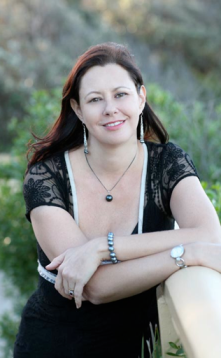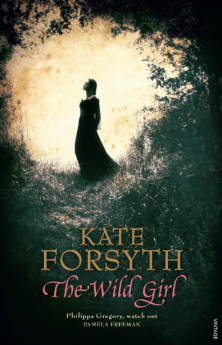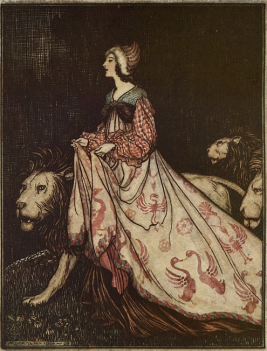On Monday night, we held our second online TBYL Event at which we meet the lovely Kate Forsyth. Kate joined us on Facebook, where we were able to enjoy her insightful answers to our fast-firing questions.
In case you weren’t able to tune in on the night, here’s a transcript of our chat with Kate, about her, about her writing, and about her latest novel The Wild Girl…
TBYL: Welcome everyone! I wanted to start with something that’s perhaps a little obvious, but interesting… what drew you to fairy tales in such a way Kate?
 Kate: I’ve been fascinated by fairy tales ever since I was a little girl in hospital and my mother brought me a copy of ‘Grimm’s Fairy Tales’. I was a very sick little munchkin and there was not much escape for me except through the pages of books. I particularly loved tales of adventure and magic and transformation – stories that took me away from my hospital bed and let me do all the things I could not do – run and fly and gallop on horseback and travel to strange and wonderful lands and have strange and wonderful adventures. I particularly loved the fairy tales, I think, because they are stories of triumph, transformation and true love, and so speak to our secret longings and desires. I wanted to be free, I wanted to be well, I wanted to be safe home and in the arms of those who loved me, and that’s what fairy tales promise us.
Kate: I’ve been fascinated by fairy tales ever since I was a little girl in hospital and my mother brought me a copy of ‘Grimm’s Fairy Tales’. I was a very sick little munchkin and there was not much escape for me except through the pages of books. I particularly loved tales of adventure and magic and transformation – stories that took me away from my hospital bed and let me do all the things I could not do – run and fly and gallop on horseback and travel to strange and wonderful lands and have strange and wonderful adventures. I particularly loved the fairy tales, I think, because they are stories of triumph, transformation and true love, and so speak to our secret longings and desires. I wanted to be free, I wanted to be well, I wanted to be safe home and in the arms of those who loved me, and that’s what fairy tales promise us.
TBYL: That’s so true Kate, I can completely relate. My love of books started when I was laid up as a kid with pretty nasty asthma. Did you have a particular favourite, either then or now?
Kate: I have quite a few. ‘Rapunzel’, ‘Six Swans’, ‘Beauty & the Beast’, ‘Cinderella’, ‘The Twelve Dancing Princesses’, ‘The Snow Queen’, ‘Sleeping Beauty’, plus many lesser known ones. I love Romany tales, and wove quite a few into my children’s historical adventure THE GYPSY CROWN. I love Scottish fairy tales as well, and drew upon Scottish folklore in my children’s time travel adventure THE PUZZLE RING. Many of my other books draw upon fairy tale and folklore as well – its what I love to do.
TBYL: I’ve seen quite a few films lately that try and do the same thing. Do you enjoy that type of adaption too, or do you prefer it on the page?
Kate: I always prefer it on the page! I so love films too, but a novel is my favourite thing in the world.
TBYL: Kate, could you please tell us a little bit about your research process? It’s clearly very thorough…
Kate: I love to research. I do it with total commitment, even obsessiveness. I want to know EVERYTHING! I’ll read anything and everything I can find on the subject, and search out lost letters and diaries and books, hoping for that elusive lost secret, that hidden fact that will make my novel come to life. It often takes me a very long time, but I’m happy and content as long as I know it will help the novel. To write The Wild Girl, I read up on the lives and works of the Grimm brothers, I studied the Napoleonic Code, I found out how laudanum was made (I could make you some right now if I had a lump of raw opium and some brandy), I found out how 19th century women made soap out of their own urine and ashes from the kitchen fire, and I cooked bread soup from my family, using an old German recipe (its surprisingly tasty).
TBYL: Would you tell us how to make bread soup? I was wondering the whole way through the book!
Kate: I’ll post the recipe on my blog for you – its very simple!
TBYL: Did you have to travel at all for your research or was it mostly done from home?
Kate: Oh no, I always travel. I feel it’s so important! I went to Cassel (now spelt with a K) and to the Grimm museum and the palace – amazing! I like to breathe the air, touch the earth, feel the cold, imagine myself into the place…
TBYL Reader (Jason): Did you have any additional scenes/chapters that were cut for the final edit… say subplots or something that did not make it in the end?
Kate: Oh yes… I thought Jakob might have been gay and I had a few scenes that intimated so… but the novel got too long and I thought I should focus on Wilhelm and Dortchen. I also cut out about 25,000 more words about Dortchen’s childhood.
TBYL Reader (Jason): Do you find making these cuts difficult or is it simply a case of stick to the main story and they either add or distract from the overall clarity of the storytelling?
 Kate: It always hurts but then I know the book is better for the cuts, and sometimes you need to write and write and write to find your story – but end the all that writing is now not necessary.
Kate: It always hurts but then I know the book is better for the cuts, and sometimes you need to write and write and write to find your story – but end the all that writing is now not necessary.
TBYL: I was fascinated by Dortchen and found myself feeling so sorry for her, whilst at the same time being impressed by her competence and bravery. Did you mean for her to be a heroine in the way that she is?
Kate: Of course! I felt a very strong connection to Dortchen from the moment I read about her. Her birthday is only a week before mine – we’re both Geminis. I thought all the time what it would be like – to be a young woman and not permitted to work, to travel, to love as you please – to live under your father’s domination all the time.
Her life was full of everything I love in a story – romance, tragedy, passion, struggle, and, finally, triumph. Plus, of course, the fairy tales. I never knew that so many of my favourite fairy tales had been told to the Grimm brothers by this one young woman. I was fascinated by her and her tales, and I wanted to rescue her from oblivion. I think we’d have been kindred spirits if we’d grown up next door to each other.
TBYL: How did you first hear of Dortchen?
Kate: I first read about Wilhelm and Dortchen’s romance in Clever Maids: A Secret History of the Grimm Fairy Tales by Dr Valerie Paradiz, which examines the oral sources of the famous tales. Dortchen’s considerable contribution was analysed, along with many others, and then – in the final chapter – it was mentioned that eventually Wilhelm and Dortchen married. As soon as I read about Dortchen and Wilhelm, I knew I had to write a novel about them. I was utterly electrified by the heartbreaking beauty and romance of their love affair and by the stories she told.
TBYL: One more about character from me and then I’ll hand it over to others… As much as I was fascinated by Dortchen, I was equally horrified by her father. I was also very confused by him. How do you go about painting such a terrible, conflicted character?
Kate: Well, it’s never easy. I struggled with what Dortchen’s tales were telling me. I didn’t want the story to go into quite such a dark place. I had to be true to the inner life of the stories, though. Nothing else made sense. Once I decided to build the story in that way, I tried to write those scenes as quickly as possible, so I could exorcise them from my imagination. I had terrible nightmares. I’d wake in the dead of night, unable to breathe, unable to make a sound, feeling the weight of it crushing me to death. It was never easy. I felt I had to write it away, write myself free, and that is what Dortchen does… though her stories are told, not written. She told stories to save herself, and that utterly pierced my heart.
TBYL: Were Dortchen’s nightmares your nightmares?
Kate: Yes. They were. Strange, I know.
TBYL: Shows an incredible investment into the story. The descriptions of Herr Wild, his clothes, his scent were horribly vivid…
Kate: Horrible is the right word. I felt it, smelt it, suffered it… I don’t know how else you can bring it to life.
TBYL: I think I was lucky that he didn’t not remind me of anyone I knew, otherwise I think I would have found it near on impossible to read a few of the more barbaric scenes!
Kate: I know a few people who found those scenes very difficult (as did I!), but then also found Dortchen’s healing and recovery so beautiful and powerful.
TBYL: Absolutely! I loved the rituals that she used to heal herself. Were these based on your research?
 Kate: Oh yes. It took me a long time to work out these scenes. I knew I needed her to go to Old Marie, I knew it had to be to do with the earth, and with old German superstitions. I knew it had to do with cleansing and exorcism because of my own dreams.
Kate: Oh yes. It took me a long time to work out these scenes. I knew I needed her to go to Old Marie, I knew it had to be to do with the earth, and with old German superstitions. I knew it had to do with cleansing and exorcism because of my own dreams.
TBYL: It was such a relief as a reader when she finally confided in Old Marie…
Kate: In fairy tales, there is often a magical helper who the hero fails to listen to and only when the hero learns to listen does the hero learn wisdom and so triumphs – Old Marie was my magical helper.
TBYL Reader (Kateness): Hello Kate, thank you for taking the time to answer our questions on your work. I am wondering if there are any other tangents of Dorchen’s story that you feel like you might like to go back and explore some more? Are you ever tempted to go back and write the story of another character you’ve met along the way?
Kate: Kateness, I always come up with other ideas of novels when I’m writing – for example, I loved Bettina von Arnim and thought what a fascinating character she’d make… but I feel I’ve done that now, I’ve done that era and that circle of friends and I want to move on now.
TBYL Reader (Barbara): Picking up, in some way Jason’s questions, have you “finished” with Dortchen and the Grimm’s now or do you imagine writing more that picks up their story? Also have you started on a new project?
Kate: Barbara, I’m always working on a new project! So many ideas, so little time!
TBYL: Can you tell us a little about your other work Kate? I’m pretty new to your collection, and I’d like to know where you think I should go next?
Kate: I’d try BITTER GREENS next. It’s a retelling of ‘Rapunzel’, interwoven with the dramatic, true life story of the woman who first told the tale, the 17th century noblewoman Charlotte-Rose de la Force. It’s full of romance, passion, obsession, betrayal, and ultimate triumph – I think you’d enjoy it.
TBYL: I’ll ask my final question for the evening. It might be a bit predictable, but Kate, do you think that you’ll keep writing your fairy tale revisits? What do you have planned next?
Kate: At the moment I’m writing a five-book fantasy adventure series for kids (I tend to alternate between adult and children’s books). Then I plan to rewrite one of Dortchen’s tales, ‘The Singing, Springing Lark’ (a Beauty and the Beast-variant), setting the novel in Nazi Germany. That will be another intense, dark, soul-shaking book, but extraordinary to research and write.
At this stage we called it a night, having typed our fingers to the bone. I hope you’ll agree, this Q&A session was a fantastic way to get to know Kate a little bit better, and I can’t wait to read more of her books.
If you’d like to find out more about Kate’s novel, you can visit her website here…
A big thank-you to Kate and to all the TBYL readers who got involved in this event.
Join us: Facebook and Twitter
Sign up for TBYL Book Club here…
Subscribe to TBYL News: All Things Bookish… out monthly!




